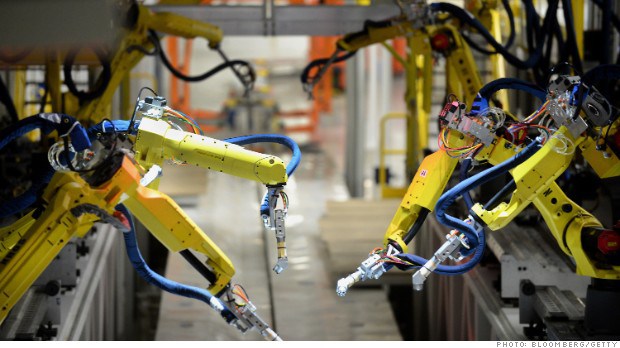Are Robots Really a Threat to Jobs?
For those concerned with bringing home manufacturing jobs that have moved from the United States to China, robots and other industrial automation tools represent a beacon of hope and an alternative to China’s inexpensive labor. But will that really restore some of our nation’s lost jobs? Commentators today have pointed out that the roles we thought were immune to the wave of automation could soon see a robotic transformation as well.
 In 1930 John Maynard Keynes predicted that technological progress would catch up with and overtake human labor, but he remained optimistic and noted that he expected this to be a phase that the workforce would overcome once robots released us from our “economic problem” and our need to work to make a living.
In 1930 John Maynard Keynes predicted that technological progress would catch up with and overtake human labor, but he remained optimistic and noted that he expected this to be a phase that the workforce would overcome once robots released us from our “economic problem” and our need to work to make a living.
But experts now face a polarized workforce and wage inequality which seems to be expanding beyond the United States, suggesting that this bleak situation seems to be growing.
Traditionally, computerization has been paired with basic rule-based manufacturing tasks like construction and assembly, but of the 700 types of jobs available in the U.S., automation is poised to take over 47 percent of them.
So far, the only security some professions have lies in the engineering hurdles that effectively keep the machines at bay. But the opposing force that is helping robots to advance comes from turning less predictable jobs into something more rule-based and thus easy to automate. Meanwhile, advances in sensors and big data have pushed the limits of robot awareness and dexterity, and thus the scope of jobs they could reasonably perform.
Jobs at the top at the “At Risk” list span from drivers that could soon be replaced by driverless cars to administrative or service occupations thanks to advances in robotic pattern recognition.
But what about manufacturing? For many, the answer to bringing jobs back home has been to invest in industrial robots that can work more cheaply than laborers in China, but how many jobs would that really create for Americans?
MIT Technology Review editor David Rotman recently wrote an article called, “How Technology is Destroying Jobs,” which sought to explain the nation’s slow rate of job growth. The article pointed to arguments made by MIT scholars Erik Brynjolfsson and Andrew McAfee, who have posited that workers are “losing the race against the machine, a fact reflected in today’s employment statistics.” They went on to argue that, “As we head[...] into the period where continuing exponential increases in computing power yield astonishing results, we expect that economic disruptions will only grow as well.”
Their evidence could be summed up in one chart. “The pattern is clear: as businesses generated more value from their workers, the country as a whole became richer, which fueled more economic activity and created even more jobs. Then, beginning in 2000, the lines diverge; productivity continues to rise robustly, but employment suddenly wilts. By 2011, a significant gap appears between the two lines, showing economic growth with no parallel increase in job creation.”
But as Robert D. Atkinson, president of the Information Technology & Innovation Foundation, set out to explain in a response article within MIT Technology Review, he asserted that there is no logical relationship between job growth and productivity in the first place.
Going back over these trends, Atkinson first looked at Japan and the U.S., both of which have annual productivity growth of about two percent. For Japan, the workforce is declining as the rate of retirement outpaces the rate reaching prime working age. The U.S., on the other hand, has a growing workforce due to higher fertility rates and immigration.
Atkinson then went onto explain that if robots really were the cause of our lackluster job growth, productivity should have grown since 2008, but the fact remains that productivity growth between 2008 and 2012 was only 1.8 percent to the 2.6 percent that occurred from 2000 to 2008.
“Brynjolfsson and McAfee’s mistake comes from considering only first order effects of automation where the machine replaces the worker,” Atkinson explained. “But when a machine replaces a worker, there is a second order effect: the organization using the machine saves money and that money flows back into the economy either through lower prices, higher wages for the remaining workers, or high profits. In all three cases that money gets spent, which stimulates demand that other companies respond to by hiring more workers.”
Furthermore, he noted that technological advances are not only followed by higher output and productivity, but higher employment as well. And for those who may say that these advances will prove to be the exception, Atkinson pointed to two problems with that argument:
“First, it assumes that productivity growth rates will increase significantly. But there is little evidence that the United States will see productivity growth in excess of three percent a year (the best we have ever done. This is in part because despite IT advances that boost productivity in information-based functions, a growing share of jobs involve interacting with people (e.g., nursing homes, police and fire) or doing physical tasks that are difficult to automate (e.g., construction, janitorial services).”
But even if he were wrong, Atkinson explained that it wouldn’t impact jobs. With any extra income, he said we would go out to restaurants more, take more vacations, buy more cars, houses, and invest further in education, all of which come from human labor.
“Pitting man against machine only stokes antipathy toward technology and could have a chilling effect on the innovation and adoption of technology essential to grow our economy. This is the last thing our economy and workers need,” Atkinson concluded.










